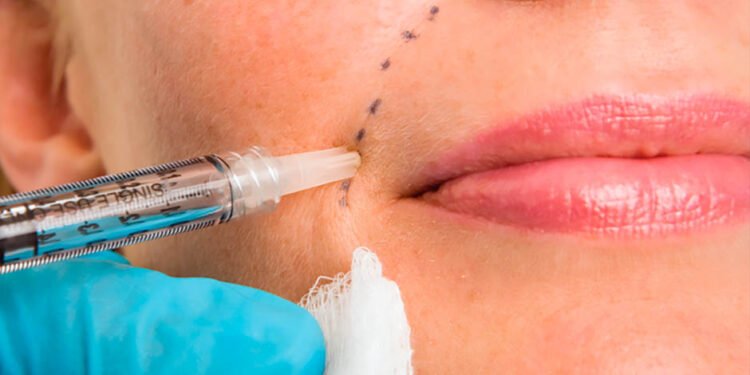What Are Dermal Fillers?
Dermal fillers are gel-like substances injected beneath the skin to restore volume, smooth wrinkles, and enhance facial contours. These fillers offer a minimally invasive solution for those seeking a more youthful appearance without undergoing surgery.
Types of Dermal Fillers
Various types of dermal fillers exist, each tailored to specific needs. Hyaluronic acid fillers are among the most popular, known for their ability to hydrate and plump the skin. Calcium hydroxylapatite fillers provide structure and stimulate collagen production. Poly L lactic acid fillers, a semi-permanent option, gradually build volume over time. Polymethyl methacrylate microspheres offer a long-lasting solution for deep wrinkles and recessed scars.
Benefits of Dermal Fillers
- Immediate Results: Injectable dermal fillers offer quick results. Most patients notice a difference immediately after the procedure.
- Minimally Invasive: Compared to surgical procedures, dermal filler treatments are less invasive, with minimal downtime.
- Versatility: Dermal fillers may address various concerns, from smoothing wrinkles and lines to restoring lost facial volume and enhancing lips.
- Natural-Looking Results: When administered by skilled professionals, fillers provide natural-looking enhancements.
Popular Uses of Dermal Fillers
Facial Wrinkles and Lines – Dermal fillers are highly effective in treating facial wrinkles, such as frown lines, crow’s feet, and vertical lines. They smooth skin folds and deeper wrinkles, giving the face a refreshed look.
Lip Augmentation – For those with thin lips, dermal fillers will enhance lip volume, creating a fuller and more youthful appearance. The procedure is popular for its immediate and noticeable results.
Volume Restoration – As we age, facial fat loss leads to a hollow and tired look. Fillers may restore volume in areas like the cheeks, under the eyes, and nasolabial folds, offering a more youthful appearance.
The Procedure: What to Expect
Consultation – Before the initial treatment, a consultation with a cosmetic surgeon or a qualified practitioner is essential. The session helps determine the best type of dermal filler for your needs and goals.
The Injection Process –The actual injection process is quick and typically takes less than an hour. The practitioner injects the filler material into the targeted areas, with results visible immediately.
Aftercare – Post-procedure care involves avoiding strenuous activities and direct sun exposure. Some swelling and bruising at the injection site are common but usually subside within a few days.
Safety and Risks
FDA-Approved Products – Ensure the use of FDA-approved dermal filler products to minimize risks. FDA-approved fillers have undergone rigorous testing for safety and efficacy.
Possible Complications – While dermal fillers are generally safe, they carry potential risks. Serious complications, though rare, include allergic reactions, infection, and tissue death. It’s crucial to choose a skilled practitioner to mitigate these risks.
Comparing Dermal Fillers to Other Treatments
Botox and Other Treatments – Botox and other treatments like facial fat grafting offer alternative solutions for facial rejuvenation. Botox primarily targets dynamic wrinkles caused by muscle movement, while dermal fillers address static wrinkles and volume loss.
Choosing the Right Practitioner
Qualifications – Select a practitioner with proper qualifications, such as board certification in plastic surgery or dermatology. Experienced professionals are more likely to deliver safe and effective results.
Experience – Inquire about the practitioner’s experience with dermal filler procedures. Those with extensive experience are adept at handling various filler types and may tailor treatments to individual needs.
Final Thoughts
Dermal fillers offer a versatile and effective option for facial rejuvenation, providing immediate results with minimal downtime. They are an excellent choice for those seeking to enhance their appearance without the commitment of surgery. Always opt for qualified and experienced practitioners to ensure safe and satisfactory outcomes and avoid potential risks associated with dermal filler treatments.
The choice of fillers, whether hyaluronic acid fillers, calcium hydroxylapatite, or poly L lactic acid, should align with your specific needs and goals. By consulting with a skilled cosmetic surgeon, you will achieve natural-looking enhancements that address issues like facial volume loss, wrinkles, and even acne scars, leading to a more youthful and refreshed appearance.
Frequently Asked Questions
What are soft tissue fillers used for?
Soft tissue fillers are used to restore facial volume, smooth wrinkles, and enhance facial contours.
How long does a dermal filler treatment take?
A typical dermal filler treatment usually takes less than an hour.
Can hyaluronic acid filler treat moderate to severe acne scars?
Yes, hyaluronic acid fillers may be used to treat moderate to severe acne scars.
How effective are dermal fillers for smile lines?
Dermal fillers are highly effective in reducing the appearance of smile lines.
Is it safe to inject dermal fillers for moderate to severe facial wrinkles?
Yes, injecting dermal fillers is a safe and effective method to treat moderate to severe facial wrinkles when performed by a qualified practitioner.












